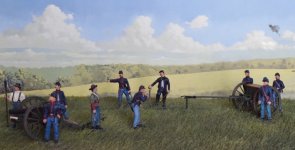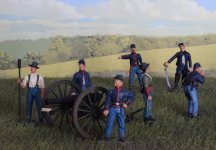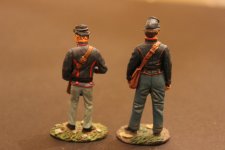mestell
Colonel
- Joined
- Feb 12, 2008
- Messages
- 8,833
Yesterday I received the newly released WB ACW #31291 Federal Light Artillery Limber w/Two Man Crew along with #31279 Federal Artilleryman Yelling for Another Round and #31283 Federal Artilleryman Standing w/Hand on Belt. It's been a long time in the making and release but it was well worth the wait. I've never been disappointed in any WB ACW sets and they have always been worth waiting on. Using the new sets and figures from existing sets I had already collected, I was able to put together the below pictured diorama featuring the new limber and a 3" ordnance rifle with a full 8-man crew along with a gun section officer and sergeant (a gun section consisted of two guns commanded by a Lt. and a Sgt.) There were three gun sections in a 6-gun battery. A battery was usually commanded by a captain.
A detachment was one gun and its crew. The crew consisted of a Gunner and seven "numbered positions". The cannoneers were: #1, who swabbed the bore and rammed the load; #2, inserted the charge and projectile into the muzzle; #3, tended the gun vent; #4 primed and fired the piece at the command of the sergeant; #5, carried the round in a leather bag to #2; #6 had charge of the limber; and #7 carried the round to #5.
When in action, the gun would be driven into position, the gun would be removed from the limber by the cannoneers and brought to bear on the target. If need be, the #1 man would use the 'worm' to remove any material from the bore and swab it with a damp sponge rammer. The gunner would decide the range, and yell that information to #6 at the limber, along with the type of round required. Then the gunner would mount the sight, and begin to aim the gun. #6 would prepare the round, using the Firing Table in the Limber Box to choose fuse time. #7 would carry the round to the #5 man who delivered it to the #2 man standing by the muzzle of the gun. He would position it in the muzzle of the gun for the #1 man to ram down the bore. All this time, the #3 man has covered the vent to keep air from any embers that may be present. When the round is seated, the #3 man would use a pick (the priming wire) to pierce the powder bag. #1 and 2 at the wheels of the gun and #3 at the trail spike would assist the gunner by moving the gun left or right. After the gunner is satisfied with his job, he removes the rear sight and steps back from the gun. The #4 man inserts a primer into the vent, attached to the lanyard, and steps back, #3 helping keeping the lanyard taut. At this time, with the cannoneers safely away from the gun, it is ready to fire. Upon command of the Chief of the piece, #4 pulls the lanyard firing the cannon. The cannon would recoil as much as 8 feet from its original position and #1,2 and 3 would move it back into battery (correct position), and the cycle starts again.
Enjoy, :smile2: Mike
A detachment was one gun and its crew. The crew consisted of a Gunner and seven "numbered positions". The cannoneers were: #1, who swabbed the bore and rammed the load; #2, inserted the charge and projectile into the muzzle; #3, tended the gun vent; #4 primed and fired the piece at the command of the sergeant; #5, carried the round in a leather bag to #2; #6 had charge of the limber; and #7 carried the round to #5.
When in action, the gun would be driven into position, the gun would be removed from the limber by the cannoneers and brought to bear on the target. If need be, the #1 man would use the 'worm' to remove any material from the bore and swab it with a damp sponge rammer. The gunner would decide the range, and yell that information to #6 at the limber, along with the type of round required. Then the gunner would mount the sight, and begin to aim the gun. #6 would prepare the round, using the Firing Table in the Limber Box to choose fuse time. #7 would carry the round to the #5 man who delivered it to the #2 man standing by the muzzle of the gun. He would position it in the muzzle of the gun for the #1 man to ram down the bore. All this time, the #3 man has covered the vent to keep air from any embers that may be present. When the round is seated, the #3 man would use a pick (the priming wire) to pierce the powder bag. #1 and 2 at the wheels of the gun and #3 at the trail spike would assist the gunner by moving the gun left or right. After the gunner is satisfied with his job, he removes the rear sight and steps back from the gun. The #4 man inserts a primer into the vent, attached to the lanyard, and steps back, #3 helping keeping the lanyard taut. At this time, with the cannoneers safely away from the gun, it is ready to fire. Upon command of the Chief of the piece, #4 pulls the lanyard firing the cannon. The cannon would recoil as much as 8 feet from its original position and #1,2 and 3 would move it back into battery (correct position), and the cycle starts again.
Enjoy, :smile2: Mike









